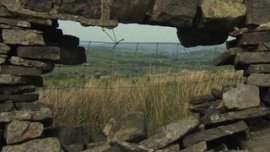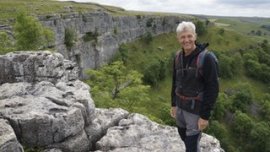The Pennine Way is a new four part documentary series celebrating the 50th anniversary of the stunning Pennine Way, presented by polar adventurer and ocean diver Paul Rose.
Paul and the team from BBC Yorkshire pulled on their hiking boots last summer to explore the 268 mile trail, which was officially opened in 1965. It stretches from Edale in the Derbyshire Peak District to Kirk Yetholm on the Scottish border.
From the highest pub in England to the Roman excavations at Hadrian's Wall and the red squirrels of Northumberland to the blustery Helm Wind of Cumbria, Paul Rose discovers the wildlife, geographical features and people that make the Pennine Way so distinctive and challenging.
We asked Paul to give us some advice on the different ways to tackle the Pennine Way, and tips on getting the most from a hike:
"For most of my life I have worked and travelled in the most remote and challenging regions of the planet - Antarctica, the Arctic, deserts, jungles, the deep sea, mountains and caves. And yet only 30 miles from my front door is a truly world class adventure that I had never done!"
The Pennine Way is a beautiful journey - it has everything; it is physically and mentally demanding, the trail runs through genuine wild places where you need all of your outdoor skills as well as easy meadows where you can relax and smell the flowers.
This year the "Long Green Trail" celebrates 50 years since its opening and I encourage everyone to give it a go!
Here are some of the different ways of walking the Pennine Way:
Self sufficient walker
The purest way is to carry everything with you and camp. It takes longer because you are carrying more weight and therefore covering less distance each day. An average fit walker should complete the walk in about 21 days. That's 12 miles per day.
Advantage: Complete freedom!
Disadvantage: Slower.
B&B trail
The most popular method is to stay at bed and breakfasts, though this does need forward planning so you can book rooms which is essential. This method means your backpack load is light and you can cover more distance each day, or take it easy and do short days, take time to see the area, rest more. An average fit walker should complete the route in 14 - 21 days depending on how easy or challenging you decide to make it. That's 12 to 19 miles per day.
Advantage: Easier, less weight to carry while walking.
Disadvantage: A bit less freedom - which means that some days are fairly short and there are a few big days where to make the B&B means a longer day's walking.
 Bag carry services
Bag carry services
Simplest and easiest is to use the baggage carry services. When you leave the B&B your overnight bags are delivered to your next stop which means that you walk each day just carrying the kit you need - lunch, clothing (rain gear or sunshine gear!).
Advantage: Travelling light!
Disadvantage: Less freedom, more expensive
Bit by Bit
Do the walk in sections. It's not always easy to take a few weeks off - so do the route in sections of 1 to 3 days. This means that you only need to either camp or B&B for a couple of nights at a time. It gives a chance to test fitness, boots, clothing and navigation and what a marvellous way to spend a weekend.
Advantage: Less time consuming and a chance to give it a go.
Disadvantage: You will get hooked, it will take over your life for the summer!
Spine Challenge
For only the hardiest outdoor type and very experienced fell runner - you could even try the Spine Race. It's billed as "Britain's Most Brutal Race" and involves an almost non stop run over a period of several days and nights.
And to make it more challenging it's done in the winter.
You can do the whole race or their version of a "fun run" which is a mere 100 miles!!
However you decide to do the Pennine Way, remember that it is a popular route so it is essential to book Bed and Breakfasts ahead, don't just expect to turn up and for them to have space.
Whether you are accustomed to rambling or this is your first hike, here are some tips to get you started on the Pennine Way:
 Think about your fitness
Think about your fitness
If you are averagely fit, have no health issues and are carrying no injuries then you are fit enough. Test your fitness for the walk by doing easy flat walks of about 10 miles. Then do the same in the hills. If you decide to improve your fitness then give yourself plenty of time - a few months at least. Over training can lead to injury so take it slowly. You are always better off starting a bit less fit than you would have liked, but injury free. You'll be fit when you finish I guarantee!
Good footwear is essential
Never buy new boots just before you start! You need lightweight boots, trail walking shoes or fell running/walking shoes for the easy bits and slightly heavier, more supportive waterproof boots for the wet days. If you can't use two sets of boots then go for the mid-weight boots and make sure you dry them thoroughly each night. This is easy in B&Bs en route as they are well used to Pennine Way walkers. Oh and change your socks regularly - always keep a spare pair in your backpack.
 Clothing
Clothing
Remember the mantra - Layer, layer, layer. A thin layer of wool or man-made fibre next to the skin to 'wick' moisture away from your skin. On top of this a mid-weight or heavier layer for insulation. Wind protection should be a light weight wind-shell. Always carry a good breathable waterproof jacket with hood and trousers. And don't forget a hat - even in the summer! Gloves - depends on the season
Navigation
It's essential to have good map reading skills and to be able to navigate accurately with a compass. If it's been a while since you did this then get out and practice. Handheld GPS's are much cheaper now and are easy to use - but you do have to learn how to use them and also to practice. To use a GPS safely you need to apply normal hill navigation skills to the GPS or you could end up trying to walk directly up a cliff, over a cliff, across a river ……..
Smart phones work well in some areas and you can use the GPS Apps with no problem - but remember there are big sections of the walk with no signal and you will be on your own.
First Aid
Carry a first aid kit and know how to use it. There is no point in taking a huge one. It should contain:
- Blister Plasters - the very best things for blisters
- Band-aids of various sizes
- Antiseptic cream
- Painkillers - aspirin, ibuprofen, paracetamol
- Strapping tape for sprains and to hold down those band aids that won't stick
- Any regularly taken medication
Communication
Mobile phones work well for sections of the walk, but there are long areas without any signal. So do carry a phone but don't rely on it too much. A battery pack charger or a second phone saves you being out of battery when you really need to make a call.
When to go
Anytime that you can make the time is the right time!
The long summer days take the pressure off as there is more daylight and of course it's warmer and, theoretically, drier.
The essentials
Always carry: Compass, Map, Headlamp, Swiss Army knife
Nice to have: Guidebook
* Don't carry too much. Remember: Weight is the enemy.
My advice is to not spend too long planning - just put your boots on and go!"
The Pennine Way will go out on BBC1 across the north of England from April 10, and will then be available on the BBC iPlayer. BBC2 will show the series nationwide this summer.

